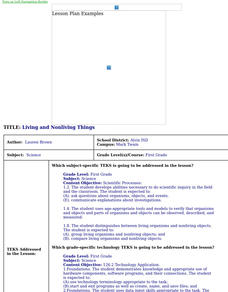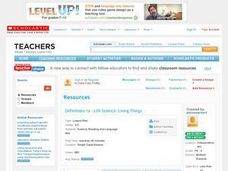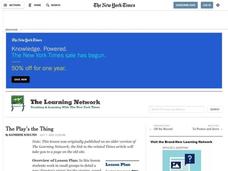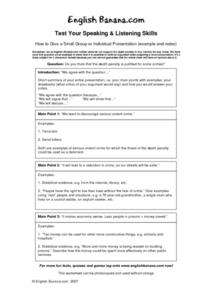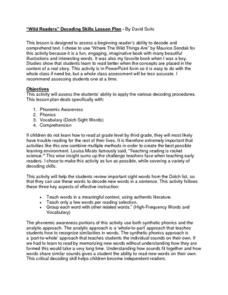Curated OER
Vocabulary Instructional Routine: Identify and Sort Common Objects into Categories
Kindergarteners build vocabulary by learning about categorization. They discuss the attributes of living and non-living things. As a class, they view and sort pictures into each category. They discuss the word category and what it means.
Curated OER
Life Science Observations: Living vs. Non Living Things
Students investigate the difference between living and non-living things. In this life science lesson, students discover the different characteristics of living things and the natural or human created non-living things....
Curated OER
Living and Nonliving Things
First graders distinguish between living and nonliving objects, and compare living organisms and nonliving objects.
Curated OER
Making Comparisons of Living Things
For this comparing living things worksheet, students examine pairs of pictures that show living organisms such as a snail, a cat, a butterfly, a giraffe, and a rabbit. They look at pairs of pictures and orally answer questions using...
Curated OER
Draw an Alien in Natural Habitat
Students apply prior knowledge of living things, structures of living things and how living things sense and respond to their environment. In this habitat instructional activity, students review the basic needs of organisms to survive....
Curated OER
Life Science: Living Things
Have your class build their vocabulary bank by studying life science terms. Basic terms like organism, cell, unicellular, and vertebrate are included on the definition sheet provided. Demonstrate how to identify different life science...
Curated OER
Sorting Living and Nonliving Objects
Third graders sort and classify objects. In this sorting lesson, 3rd graders sort small objects such as cereal or candy. Then, students classify and sort objects that are living or nonliving.
Curated OER
Living Things
First graders learn to group living things,basic needs of living things, that there are many different living things and that each has an environment. Students learn how living things adapt to both their environment and for survival...
Curated OER
Anansi and the Tug O' War
Read a short book with your first graders! Anansi and the Tug O' War is the focus of this lesson. After reading the African story together, they complete language arts activities to practice reading comprehension. A stellar...
Curated OER
Every Living Thing
Students read the book "Every Living Thing." They read one story at a time, and participate in various activities. Some of these activities include the following ideas: Students write about a time when they were in a similar situation as...
Curated OER
The Play's the Thing
Students describe to a partner theater experiences they have had in their lives that were memorable, and analyze why. They study about one director's original artistic choices for staging Shakespeare by reading and discussing "Nature's a...
Curated OER
Test Your Speaking & Listening Skills: How To Give a Small Group Or Individual Presentation
How do you structure oral presentations? Guide your orators with this plan. Groups of English language learners will practice presenting their opinion in response to the question "Do you think the death penalty is justified for some...
Curated OER
The Living Environment
Students explore the cycles of an ecosystem. In this environmental science lesson, students work in groups to research the nitrogen cycle, the water cycle, or the oxygen-carbon dioxide cycle. Students prepare a PowerPoint or other...
Curated OER
Scavenging the Sandy Shore
Students explore oceanography by examining a beach. For this living things lesson, students define the terms abiotic and biotic and practice identifying living and non-living things that have been previously found on a beach. Students...
Curated OER
It's Alive
First graders critically analyze living and nonliving objects, then develop a list of characteristics to classify objects on a science walk. They make a book to close out the lesson.
Curated OER
Hunters and Gatherers
Sixth graders participate in mapping and other activities to understand why ancient civilizations developed as they did. In this ancient civilization lesson, 6th graders recognize that there were three important climate zones and...
Curated OER
Investigate Science Using Crayfish
Young scientists discover the importance of scientific investigation by observing live crayfish. They carefully observe the patterns of crayfish in different environments. Then they discuss their conclusions and define what all living...
Scholastic
My Favorite Activity (Grades K-2)
Scholars discuss the many ways they use persuasion in their everyday lives and brainstorm specific ideas for encouraging someone to do something. With the list of persuasive techniques they made, young writers complete a graphic...
Alliance Theater
The Jungle Book Post-Show STEAM Lesson
An ecosystem is really just the flow of energy through many different living organisms. A study of Rudyard Kipling's The Jungle Book leads to an environmental science activity in which learners study how various factors can affect...
Curated OER
A Small Book of Small Things
Students explore size relationships as they collect pictures of the small things in their world. In this early childhood math and literacy lesson, students gain an understanding of size differences and develop fine-motor and literacy...
Curated OER
Word Hunt
In this word hunt learning exercise, students make lists of things that . . . are described in phrases. Students name thirty groups of things.
Curated OER
Snowy Similes
The class defines similes after creating a KWL chart about them. Groups rotate through a series of stations in which they creatively complete similes. They create a picture booklet that contains similes. However, the booklet topic and...
PBS
The Lorax
Accompany a reading of Dr. Seuss' tale, The Lorax, with a five-item worksheet. Questions challenge scholars to list characters' names, use text details to answer inquiries, and describe the moral of the story.
David Suits
“Wild Readers” Decoding Skills Lesson Plan
Set young readers on the path toward fluency with this phonemic awareness resource. Based on the award-winning children's book, Where the Wild Things Are, this lesson allows beginning readers to practice isolating...


